by B.B. Pelletier
Today’s blog is reprinted from Airgun Revue #5, which was published in 1999. If you’ve ever attended some of the larger airgun shows, you’ve seen airgun collector Roger Blaisdell. An all-round nice guy, Roger told me about some of his recent acquisitions.
Roger Blaisdell is an advanced collector from New England who often comes up with the most startling finds. Like most advanced collectors, he keeps his sources under tight wraps but is more than willing to share his finds with the rest of us. At one of the annual Airgun Expo shows in Little Rock, Arkansas, Roger showed me three most remarkable finds he had discovered recently. He asked me to show them to you, and I’m happy to do so.
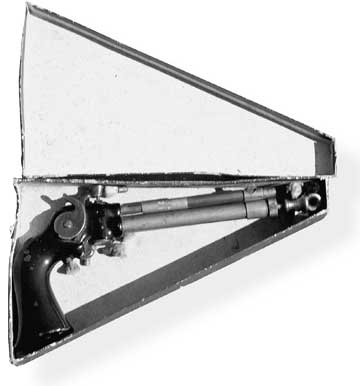
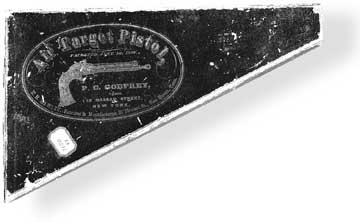
The first great airgun goes by several names. Some call it the Hawley, after the manufacturer, Edwin H. Hawley, while others call it the Kalamazoo, after his hometown in Michigan. If you didn’t know this, however, you might be tempted to call it a “Godfrey,” for the name of the sales agent printed on the box–or possibly a New Haven Pistol, for the city of manufacture, also printed on the box–assuming you had a box, of course. Of the roughly 10 Hawleys I’ve seen in my life, only this one has its original cardboard box–an item that I feel must certainly be as valuable as the gun inside.
Edwin Hawley patented his multi-pump pneumatic air pistol on June 1, 1869, just a few short years after the end of the Civil War. In 1871, he obtained another patent, the one that actually covers the pistol as it was built, but that date appears nowhere on the gun or the box. The earlier date is stamped on the barrel of the gun and is the only marking to be found. But advanced collectors can pick a Hawley out of any lineup. It has such Victorian lines, it almost seems to be a caricature of a pistol rather than a working model.
The correct finish for a Hawley is nickel-plating on all the brass parts, with the steel hammer and cast iron pump handle left in the white. The iron grip, which also serves as the reservoir, is painted shiny black, a process known then as “Japanning.” I once saw an almost-perfect Hawley that is now in the collection of Fred Liady, and it was a most striking sight. Roger’s gun has absolutely no trace of nickel anywhere, which leads him to wonder whether it was ever finished at all. I believe that it was; and that when most of the nickel flaked off, as will sometimes happen, some owner took it down to the brass. We certainly see this often enough in Benjamin guns from the 1930s.
You probably wonder how well a gun like this shoots, and I share that question, for I have never seen a Hawley discharged. I do know that it is designed as a dart gun, and lucky Roger seems to have acquired several of the original darts with his gun. Dart guns are not usually powerful, and this would seem to hold true for the Hawley. In a famous ad from an 1870 Scientific American magazine, it was claimed to get from five to ten shots, good out to 50 feet, from a single charging. Nowhere, however, does it say how many pump strokes are involved in this charging. Judging from the shape of the mechanism, I would bet a charge is somewhere between 10 and 20 strokes of the pump handle. Of course, darts fly much slower than pellets, so this is really a weak air pistol, even with its multiple shots.
The pump handle is a cast iron knob on the front of the pump rod. It has a hole through it for the insertion of an auxiliary handle of sorts, which seems to be missing from the box. Perhaps there never was one, and the customer was expected to figure things out for himself.
The handle worked straight in and out in the manner so familiar to collectors of vintage “bicycle pump” Benjamins. When pumping was completed, the barrel was slid forward, and the dart was loaded directly in the breech. A simple design, but you must remember–this was the first American air pistol to use it. The Quackenbushes and Haviland & Gunns were still in the future when the Hawley hit the market, so whatever we see here was happening for the very first time.
Hawleys are rare enough, but they’re not unheard of. What I mean is that you can find one if you really want to. Unlike some other guns, like the Brown Pneumatic pistol, Hawleys do become available from time to time; and collectors who want them can find them. I think Roger’s find of a boxed example has to be one of the best finds I’ve ever heard of.
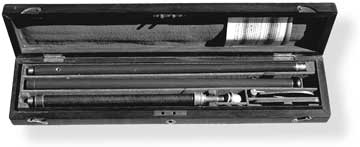
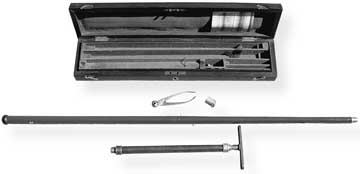
His next find happened at the famous Maryland Arms Collectors Show in Timonium. I was privileged to be there to see it happen. That show was such a super one in 1999, as there was an original Bates ball reservoir pistol with a SIGNED pump, as well as dozens of other fine airgun collectibles. One of them was a beautiful cased air cane whose owner walked right straight up to Roger and made a deal. Air canes are always of interest–especially cased sets like this. But this one is very special.
According to convention, air canes are measured for relative size across their diameter at the junction of the two halves of the cane. Most common canes measure about 1-1/4″ to 1-1/2″ at this point. Roger’s cane measures just under 3/4″, which makes it a most diminutive and dainty cane. It’s also too short to pass as a walking stick for all but a very short person, say under five feet tall. Of course, not all canes were used that way in the Victorian era. Some were simply carried as larger versions of the military “swagger stick”–a fashion statement instead of an aid to walking. If the cane were also a pneumatic weapon, the owner no doubt felt well-protected.
The tools in the case seem very complete. There’s a pump body with detachable foot rest, an oil can, a bullet mold, a key for cocking and even a set of printed instructions for the gun. The bullet mold appears to be a replacement, but everything else looks original.
The pump tube is fashioned from rich Damascus twist steel, in the manner of the finest firearms of the past century. It’s browned to a deep chocolate color, which brings out the grain structure in the twisted steel and iron bars that were hammered into the round barrel. And it operates smoothly, having a hand-lapped piston with no leather seal. Just a drop of oil before starting was all it took to seal the pump perfectly.
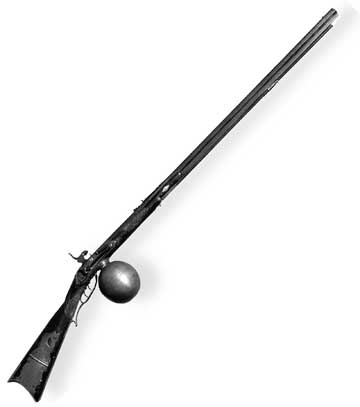
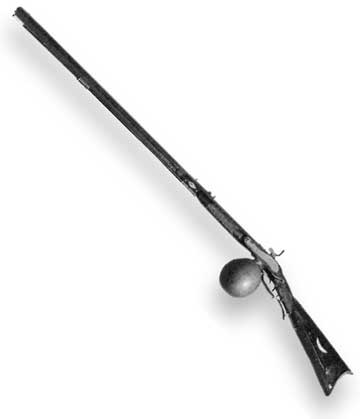
The last find Roger made is one he’s been searching for many years–a ball reservoir air rifle. Several times he’s been within striking distance of his goal, only to have it snatched from his grasp. But perseverance paid off because he now owns one.
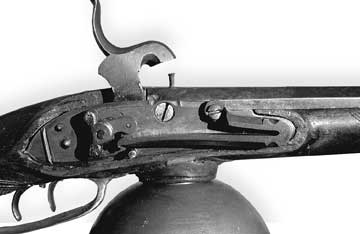
Roger’s ball reservoir gun has a one-piece brass reservoir as opposed to copper or iron hemispheres joined at the middle. The lock seems to be patterned on the German bar lock but is just a bit different than those. Actually, the gun closely resembles a gun in Wolff’s book, Air Guns, which he refers to as an “American ball-reservoir Kentucky rifle.” The author states that he’s unsure of the country of origin of the lock, which is the whole gun as far as an airgun goes, so the use of the term “American” seems to be based more on the outward appearance of the gun rather than on concrete provenance. Roger’s rifle certainly resembles a half-stock Kentucky (or Pennsylvania, for the purists) than an English or German airgun.
The lock is half-concealed and half-exposed. The hammer is behind a metal plate and appears to be inside the lock, but it’s not. But the mainspring that powers it is connected on the outside of the gun, a very strange arrangement that may lend support to Roger’s belief that this is not an English or German gun.
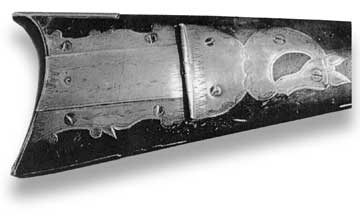
The brass patchbox on the right side of the butt and is made of pierced brass in the shape of a stylized horse. The workmanship looks very much like primitive American gunsmithery, lending even more credence to Roger’s beliefs about the gun’s origins.
Under the octagonal barrel, a wooden ramrod rides in a brass thimble, also lending to the primitive look. Of course, on a gun like this, a ramrod is very necessary, for they were loaded in exactly the same way as the firearms they copied. A patched ball would have been the only practical projectile, as the low airgun velocities would never stabilize a conical bullet. All the hunter would have lacked is the powder and, in later days, percussion caps, to distinguish himself from any other riflemen of the time.
Roger is most pleased with this find, although a little curious as to the true origins. With just the sketchy few paragraphs from Wolff’s book to go on, he’s reluctant to state positively that he has an American ball reservoir gun. The signs look good, though. Anyone who might be able to add information about the origin of Roger’s unsigned airgun should comment on this blog, and I’ll pass along the info to him. Thanks to Roger for his generosity in sharing these guns with us.
I'm not a collector of airguns, probably never will be, but I sure enjoy these stories and pictures that trace the lineage.
The American made? ball reservoir gun is fascinating. Have you seen the Calverts ball reservoir gun that has a damascus barrel for sale in the used airgun section at crooked barn?
kevin
Looks like there may finally be an extreme heavy weight .22 cal pellet worth its salt.
http://www.network54.com/Forum/79537/message/1253174953/JSB+Monster+25.4+gr+.22+cal+pellets.++First+impressions+and+group.
Volvo
Brass ball reservoir – what sort of working pressure do you figure it normally used?
Hi B.B.
Do you have any thoughts about using the Sportsmatch TO6C mount on a Supersport? There is also a B-Square 10585 mount that claims to fit, but it's for a 12mm dovetail so I'm skeptical.
What's the drawback to using two piece mounts on a springer, assuming that it has a stop pin as the two above do?
Thanks,
Dino
Volvo,
Saw that earlier. Hard to keep up with the "apparent" top quality new airguns and new airgun products that are being introduced almost daily.
That interesting new heavy pellet from jsb seems to need a more powerful gun than I own to push it to the ideal? 875 fps? I'm gonna try it in the s410 though. Can't help it. I'm hooked.
kevin
Vince,
Brass balls are safer than iron balls, in that they don't fail catastrophically. They can generally take 600-800 psi, which we proved the vintage pumps could generate.
B.B.
Dino,
There is no drawback to 2-piece mounts on a springer. The drawback is on 1-piece mounts, in that they cannot be placed anywhere but in a single place.
Mount clamps are made to accommodate tolerances. Don't fail to buy one for a single millimeter.
B.B.
I wondered about 1-piece vs 2-piece on springers. I read in various forums to use a 1-piece, I assume because the clamping pressure is higher. But with a stop pin, I couldn't figure out why it would matter.
So, between the TO6C and 10585, which would you recommend?
Dino
Would appreciate suggestions.
I'm bored easily and would like to add some "targets" to my range. Have several reset targets (gamo squirrels), paint balls set on golf tees (cheap targets), swinger targets, 3 pellet traps for paper targets (20 yards, 35 yards and 107 yards) and occasionally throw plastice golf balls into the range and everyone can in unison shoot until the ball is out of sight (in the willows or in the swamp).
When you're done shooting for accuracy/pellet testing what do you like to shoot for fun?
Don't have any moving targets. Anyone use a Caldwell Shooting Arcade or the Gamo Moving Target system?
kevin
Volvo,
Thanks for reminding me about my post on the Vintage forum.
I did find a picture of a box of pellets made by Cox and Sons which are marked "Best in 1902." The pellets evidently were used in some sort of Championship shooting contest. This predates the Lincoln-Jefferies gun by a couple of years.
I also posted in the yellow and the pellets collectors forum.
No doubt the diabolo was a iteration from various bullet designs.
Some unlucky fellow missed the boat. A lot of patents on early gun designs. A lot patents on firearm projectiles. But patenting pellet designs seems to have occurred much later.
No doubt the expectation was the inventor would rather patent the gun worth $10 than the pellets which are 0.25 for 250! LOL
Promethius pile drivers pellets, Eley magnum bullets and now JSB exact jumbo monster. Some heavy ammo out there. Usually can't go wrong with JSB. The other two tend to run over a dime a unit. I've been having really good luck with the eun jin 34.2gr points in my Discovery and they run around 6 cents a pellet.
I got my Benjamin pump dirty. There is a lot of dust on my metal shaft and I do not want to wipe off the grease. If I do, is there a good place to get some Parker super O-lube or equivalent type silicone grease? Would plumbers or lithium grease work too?
Dino,
Can you verify if your BSA Supersport has 14mm dovetails/maxi grip rail or is 11mm?
If it's 14mm (like I've read it is on Supersports), then realize that the B-Square 10585 mount is designed for use on BSA guns with an 11mm rail/dovetail and will cause problems on your gun.
The B-square 10600 is designed for the BSA 14mm and so is the 17501. The major difference being the 17501 is adjustable and the 10600 is fixed (I'll never buy a B-square adjustable mount again unless it's a very older model. New ones have smaller screws and won't stay adjusted in my experience).
The BKL 463 double strap is what I see most people using on the BSA's with 14mm.
The Sportsmatch TO6C mount may also work if your rail/dovetail is 14mm but I don't have any experience with it and don't know of anyone using it on a BSA Supersport.
Make sure your ring size fits the scope you want to mount.
Please double check this and wait for B.B.'s reply since I've never owned a supersport but read a lot about them. Great reviews.
kevin
Dear B.B.
Yesterday, I swapped the stock of my Daisy 853c with The stock from the TargetPro 953. I got the inspiration from your blog on the 953.
Yes, it made quite a difference. The Monte Calo stock and pistol grip makes offhand shooting much easier.
Daisy wanted $65 just for the TargetPro 953 stock. The entire rifle is available from PA for $72. So I just ordered the rifle from PA. For $7 more, I got an extra rifle.
Earlier, I installed an AirForce Diopter sight. Now with the new TargetPro 953 stock, I have a very good and affordable target rifle.
Thanks BB. It was your blog on the TragetPro 953 and AirForce Diopter sight that gave me the idea to make these modifications.
I highly recommend these to other 853 owners.
Thanks again,
Stingray
B.B.
The air cane is right out of the James Bond. The ball reservoir may be efficient (or not) but it has a ways to go in the looks department.
Kevin, a new world of challenge will open up with instinct and rapid fire shooting. Speaking of which, do you suppose that a heavy trigger is better than a light trigger for such a gun? If so, it could be that the Crosman 1077 is really the ultimate for this activity regardless of price. With its heavy trigger, light weight, and short length, I don't know of anything better.
Matt61
Just one comment on the stock and Edge sights. Making such changes in the 853c will make it in-eligble for international sporter competition. You can't swap stocks and the Edge sights are not allowed because the line of sight is 7mm to high (a ridiculous rule…but there nevertheless).
If you're just shooting recreationally though…go for it.
CowBoyStar Dad
B.B.
Wow, thanks for sharing those fine pieces from the past.. Like Kevin, I really enjoy the history.
Volvo,
thanks… I'm sure it was the beer.. yours and others here encouragement, gets a lot of the credit for getting me started.. and helps keep me practicing hard!
This Saturday in Washington State is the real test! .. NW title is on the line.. Last week Rick (my teacher/mentor) won the Idaho state match, and he and many others will be at their best with the Washington State title on the line.. and then there's us outside dark horses.. errerr aahh.. make that burros..
off to practice..
Wacky Wayne,
Ashland Air Rifle Range
Dino,
I have zero experience with those Sportsmatrch mounts, but like Kevin, I know they are good. B-Square, on the other hand, seem to be slipping lately. People seem to be stripping screws in them. So go with your gut and get the Sportsmatch.
B.B.
Matt61,
"a new world of challenge will open up with instinct and rapid fire shooting".
Forgive me but you lost me. Are you talking about the moving targets I'm thinking about adding to the range?
Never been a rapid fire or instinct shooter that I know of. Got to be pretty good at trap and sporting clays. Point and shoot. Since that was with shotguns, the trigger didn't matter since you just slap it anyway.
Don't think I've been much help.
Have you run any of those pellets through your gun that had the loose fit?
kevin
Kevin,
Look at this man's targets:
http://www.noteworthytargets.com/
We had him on the show and I like what he makes. The website appears hosed up right now, but if it clears up, you should look him over. The targets are great!
B.B.
Stingray,
Thanks for that feedback.
B.B.
B.B.,
Thanks very much.
I've got two of his re-set targets. One of my favorites is not on his website. Four white quadrants with an orange bull in the middle. Hit the bull and the thing swings around but hit the quadrants and they move very little (are heavier) and reset themselves. VERY well made. Heavy duty even for a hard hitting pcp at 20 yards.
kevin
Kevin,
Thanks for the reply. The rails are 14mm tip-to-tip, but I don't know if the measurements are taken a bit 'inside' the dovetail. B-Square web site refers to the Maxigrip as a 13mm. There must be no standard on that point.
B-Square appears to be going under, and BKL also, as far as I can tell. The 17501 was my first choice, but I haven't been able to find it in stock anywhere (US/Canada). I can't find any mention of the 10600 model, even on B-Square's site. The 10585 is 12mm per the B-Square catalog (and in stock), so perhaps 1mm undersize (close enough?) for my rail. This is my first scope installation – it's not supposed to be so difficult!
I haven't found any BKL 460 series in stock anywhere. I appear to have limited options.
Dino
Dino,
Take a deep breath. It's not usually this hard but you're doing the right thing in thoroughly researching before buying, waiting, finding out they don't fit/barely fit and don't work, ship them back, maybe get a refund, then start all over to find the right mount/rings.
Take your time.
I've heard varying things about B-Square. BKL's are now being made again after a change in manufacturers. Airforce is now making the rings and mounts and are trying to catch up on back orders. The bkl 460's were supposed to start shipping 8-31-09 but that date has been pushed to 9-30-09. Even though Airforce is making these mounts and rings they are not on their website. You will have to go to the bkl technology site to see pictures, prices and in stock dates. Many of the bkl product is in stock however.
In my humble opinion you were lucky not to find the B-Square 17501 in stock anywhere since it was your first choice.
If you can't wait for the bkl's, as B.B. said, Sportsmatch makes great mounts. They're also marketed under the Beeman name. As I previously posted, "The Sportsmatch TO6C mount may also work if your rail/dovetail is 14mm but I don't have any experience with it and don't know of anyone using it on a BSA Supersport." The TO6C is in stock where I checked.
kevin
Dino,
Sorry, forgot to answer one of your questions.
No, do not use the B-Square 10585. These are the very rings that have caused problems on the BSA 14mm rail/dovetail. They only have clamping pressure on one side and not only have been known to lift the lip of the rail/dovetail but because they aren't the correct size for YOUR BSA they cant the scope (make it lean in one direction when mounted).
kevin
Vince,
Finally made a spanner driver to remove the front sight of the TF97. Discovered the screw does nothing but hold the driven pin in place.
So the problem is that the pin does not hold the sight tight. Can not see an easy fix that does not involve machining or epoxy.
Was able to make it much tighter by turning the pin 180 degrees and putting the slot of the spring pin facing up instead of down. Now it only moves a little bit.
Do you have any thoughts?
Dino,
14mm refers to the dovetail separation, or inside the grooves. Unfortunately, there is no standard way of measuring that. Since dovetail grooves are cut on different angles, wider one may actually be narrower.
B.B.
BB,
Now we're talking vintage. The Kentucky almost looks as if someone took a left-hand lock and mounted it (with modifications) inside out, so that instead of a cap or primer pan, the hammer struck the valve? The rifle itself looks like it could be late production (even late percussion era?). Perhaps a small manufacturer was losing sales rapidly to the new cartridge rifles and retrofitted some old stock and/or tooling for pneumatic use?
I can't tell why you refer to it as half-stock, which would take it out of the Kentucky class and make the horsehead patchbox even more anachronistic, but the pictures arent that clear — it seems to me that the wood extends all the way to the muzzle, whereas a half-stock (e.g. Hawken) would have an iron rib suspending the ramrod thimbles. Perhaps I misunderstand either the pictures or the use of the term half-stock. Maybe I'll buy a PCP after all:).
Herb,
I must have misunderstood your example last night: Wouldn't a projectile fired from a horizontal bore be at the apex of its trajectory right at the muzzle? That case would be most uncommon, but I don't see that it disproves my conception, which didn't intend to state strictly that the apex was the point of instability, but simply that the apex was a critical point where the two yaws are clearly at odds and begin to diverge quickly. That still seems to be the case with a horizontal boreline, as far as I can see.
At any rate, it would seem like a matter of how much the angles sought by spin and drag diverge as to whether the dual stabilization results in normal, stable or erratic, unstable precession, and the amount of divergence seems to depend on the angle of elevation. Doubtless there are other variable causes of possible instability, but this one seems to be designed into a pellet stabilized by drag and simultaneously spun fast enough to have gyroscopic properties.
HELP EVERYONE
MICHAEL HAS ASKED THESE QUESTIONS:
"I recently purchased an RWS 48 in .177 caliber. The rifle itself is top quality. I live in a residential neighborhood. I've only put a few pellets through this rifle because of the amount of noise it produces. It almost sounds like I am shooting a 22 rimfire.
My question is…..how much quieter will the rifle become after break in (say a couple hundred shots)?
If it doesn't get much quieter than most likely I will need to exchange it for either the Gamo Whisper or the Crosman NPSS. Which would you recommend more & why?"
PLEASE ADDRESS YOUR KIND ANSWERS TO MICHAEL.
B.B. SAID,
Michael,
I suspect that if you have shot your rifle since sending that comment, you already know the answer to how much quieter your gun will get. You have had a few detonations. The way to end them is to continue to shoot the rifle.
The oil droplets in the compression chamber are being ignited by the temperature of the compressed air, much the same as a diesel engine. That will only happen a few times with an RWS Diana 48. After that, there will be the sound of a releasing spring and a piston stopping rapidly, which is nothing like a .22 rimfire.
The rifle will not become much quieter after that point. It can be heard 50 feet away at all times–but that is true of most spring air rifles. The NPSS is quieter, but no spring air rifle is ever completely silent.
However, the lower the power, the quieter these guns can be. A Hammerli 490 tuned by a competent airgunsmith would be almost impossible to hear 50 feet away.
If quiet is what you need I suggest you get a much less powerful spring piston rifle, or consider the Benjamin Marauder precharged rifle, which is one of the quietest air rifle on the market. I doubt it can be heard from 35 feet.
B.B.
I have actually done a (un)fair bit of waiting already for the 17501, because I've had an order in for over a month now and the expected date just moves out a week at a time every Thursday. Need to cancel that order and decide Sportsmatch or BKL.
Thanks B.B. & Kevin, you have both saved me a lot of continued frustration.
Dino
About the Benjamin Marauder,
I was just reading about it today and fell in love with it. But, big problem (for me), it is prohibited in Canada. The barrel shroud has been deemed a silencer per the Canadian criminal code definition and it can't be imported. The Canadian Firearms Centre told me that the manufacturer's literature advertises it as reducing the noise (don't know, I haven't seen it myself), so it's likely going to be impossible for anyone to convince them to allow it in. Unless Benjamin comes out with an unshrouded version, I'm probably out of luck.
Dino
BG_Farmer,
RE:Apex
My point was that I don't think that there is anything special about the "apex."
Shoot absolutely horizontal. No apex.
Shoot 5 degrees up. Now you have an apex, but the overall curve is almost identical to shooting horizontal.
Traced the horizontal shot onto a sheet of plastic. Rotate the curve 5 degrees up and the horizontal curve would be identical to the shot at 5 degrees up. Any difference that you could calculate with a computer would be lost due a few fps difference in muzzle velocity.
The point is simply that the greatest change in angle per unit time is at the muzzle. The horizontal shot was an easy way to try to create a visual image.
—–
I hope this make sense…
I guess I "jumped the gun" a bit. After looking at my pump, it was only dirty on the bottom 1/2" of the pump shaft. I wiped off the dirt and pumped it a few times. The grease from the rest of the pump shaft redistibuted evenly on the shaft.
As for silicone grease, many have said look for 100% silicone grease in the plumbing section at your local hardware store. Gunk from Lowe's was one example.
For now I am covering my pump with a plastic bag for a dust cover and keeping pets and kids away from it. Filling the Discovery with a pump was one of the biggest selling points for me in getting a PCP.
Herb,
I know what you are saying, but there is an apex (or highest point), even with the muzzle horizontal, and that apex is at the muzzle. I doubt the 5d rotated curve would look all that similar to a shot with 5d of elevation, since the horizontal boreline is a special case. As far as I can see, the horizontal case will look like half of a parabola, starting at the apex.
I disagree that the "greatest change in angle per unit time is at the muzzle". The spin of a projectile keeps it in line with the boreline, which in the case of a "normal" (non-horizontal) shot will be "nose-up". Until the apex, the drag-stabilization will also produce an orientation "nose-up", although the angles will begin diverging at the muzzle. At the apex (and more thereafter) of the trajectory, however, the angle sought by drag will be "nose-down", but the spin induced angle will still be "nose-up".
BB,
Amazing how many unique air guns exist. Good blog article!!!
You guys looking for new targets?! Try these:
http://www.letargets.com/zombies.aspx?utm_source=LET+Subscriber+List&utm_campaign=96d9f0ac2f-Zombie_Promo_9_16_2009&utm_medium=email
These will help you get a proper sight picture when the infestation occurs.
-Chuck
Herb and BG_Farmer,
I'm not sure why you are looking for the point where the "greatest change in angle per unit time" is located, but I think to agree on this you'll need to agree on the definition of the angle that you are looking at.
If it truly is the difference in the angle between the bore sight and a line segment from the muzzle to the pellet, then it may be as soon as the pellet exits the muzzle as the resulting line segments are extremely short and thus the "delta Z" from gravity works to create a relatively large angle out of the very small displacement.
But I think what you would be more interested in the point where the change in angle between the axis of the pellet and the flight path of the pellet occurs (yawing). Even when one considers the impact of crown or muzzle blast effects, this would be farther from the muzzle than discussed above due to aerodynamic effects that start once the pellet is out of the muzzle. Furthermore, the effects "per unit time" will increase as the pellet slows down, again due to the shortening line segments per unit time, plus the "delta Z" from gravity increases per unit time over time . . .
I don't know if that helps or not – but I am trying to help!
Alan
but it most certainly is not near the muzzle
Sorry – the last bit after my name was a left over from editing and is meaningless. . . .
Alan
Kevin,
I meant stationary targets where you empty the magazine as fast as you can or where you whip up the rifle/pistol and fire instantly like Clint Eastwood. Whether the target is moving relative to the muzzle or the muzzle to target, there's a basic equivalence. Heh heh.
I am just finishing up a tin of JSBs. I'll start your tin tonight and have a report tomorrow.
Michael, my B30 is a copy of the RWS 48. I stick the muzzle in a cardboard box, and I shoot in a room adjoining another apartment in a crowded complex with no complaint. With the door of the room closed, you can barely hear it. It's like a homemade, legal silencer.
Matt61
BG_Farmer,
RE: "Apex" & rate of change
You're right.
——
Without air, the shape of the pellet's path would be a "pure" parabola.
Shoot at an angle THETA.
From the tangent to the parabola we can figure out the "instantaneous angle" of the path of the pellet.
The first part of the pellet's path is nearly linear so there is very little change (per unit time) between THETA and the tangent to the curve.
Same thing as pellet falls. The slope of the path is nearly linear. At that point the nose is pointed up at angle THETA but the path is falling down at virtually a constant angle of -THETA.
Now draw the two lines (from start of path & end of path) to point of intersection. Draw a third line halfway between the first two. The third line will intersect the parabola at the "vertex" to which you have been referring as the "apex." [I'm determined to squeeze out a small concession here to try and cover my stupidity… ;-)]
Regardless of how the pellet it shot, the third line will cross
the parabola at the vertex. If the pellet is shot up then the third line will intersect at the "apex."
Think about shooting down. There never is a "apex," but a parabola always has a "vertex."
——–
Now that I've gotten over my stupid, your analysis is very interesting…
The pellet could perhaps become unstable as:
(1) the absolute difference in orientation compared to path passes some critical value
–or–
(2) as the relative change goes though a maximum. This would be kind of a point of "maximum stress." As you point out if we shoot the pellet up, then this is the "apex" of the pellet's flight.
Geeze Alan,
The last part wasn't meaningless, it hit the nail on the head!
any & all can anyone tell me how the noise level of the marauder compares to a daisy 953? Hank
Herb,
I kind of started my post that way, but realized almost as soon as wrote it that we need to be very clear on what we define in order to make such statements, and didn't want to offend if I had misunderstood something . . . . but ehn I forgot to delete it. Glad you figured it out anyways!
Just checking – in your new explanation, is there a specific point in time at which you choose to draw the "third line"? It will not always intersect the apex – in fact it should only do so once and that is after the pellet passes the apex of the parabola. Or do I not understand it correctly?
I also think the answer to how the instability arises probably has some interplay with the deceleration of the pellet in flight. The dynamics of stability, even without any perturbing forces, are constantly changing – most dramtically with the decline in drag stabilization with respect to spin stabilization as the pellet slows (which it does very quickly).
Alan
Hank,
I can answer your question but not right now. I'm on the road but I'll be able to answer next week. By then you may have other opinions but I'll send mine anyway when I get home. Right now, without actually verifying it with my rifles, I'd say the Marauder is quieter – and at least not louder.
I am looking for a powerful yet quiet .22 air rifle. The Marauder & it's accessories are out of my price range.
Which would you recommend more & why: a Gamo Whisper model (with Air Venturi) or the Crosman NPSS?
Michael,
Have you read the reports BB made on the NPSS? Go here and read the 4 part series:
/blog/2009/08/crosmans-new-nitro-piston-short-stroke-part-4-addendum/
At one point in Part 1 BB said:
"And, when it comes to the relative noise a Crosman Nitro Piston makes, it's less than a Gamo Whisper, but just about the same as a Whisper with an Air Venturi gas spring installed."
But you should read all 4 parts if you're really interested.
-Chuck
Herb,
I still don't know if it makes a difference, but thanks for taking the time to figure out what I was saying. Vertex is fine — and your expansion is just what I had in mind.
Alan,
You did help. As Herb said, it could be either way, either the angle difference reaches a critical state or the change in angle difference is too rapid.
Alan,
I'll try again to cover up my stupidity again and say that the word "apex" was what mislead me…
Think VERTEX of the parabola. The "third line" that I mentioned would ALWAYS intersect the parabola at its vertex. It doesn't matter if you shoot up horizontally, or down. The parabola still has a vertex.
Of course this wouldn't be quite true for a "real" pellet being shot in air. If you shot upward, the first part of the flight would be mostly parabolic, but the pellet wouldn't go as high as it would in vacuum. Also the downward fall of the pellet would be steeper than the upward flight. So the pellet's flight would not be symmetric. But drawing the a line at an angle halfway between the initial and final paths would still be pretty good to find the "vertex" of the curve.
—-
At least it is harder to offend me than it is to get me to listen! Sometimes I'm too busy trying to make my point to listen…
😉
—–
BG_Farmer
Thanks for keeping my feet to the fire…
You figured out something which is very interesting!
Herb
Chuck,
Thanks for helping Michael.
kevin
CJr. Thank you. I will look forward to your answer next week. Hank
Kevin – Thx for advising me to post on the newest blog.
Chuck – I have founds tons of useful info by using the search engine.
BB – The NPSS review was great.
Mahalo ~Michael~
Michael,
If you read all the reports you picked up that the Whisper, while great in .177, falls short on power in .22. Probably a swept-volume thing.
The NPSS has no such problem. I'd say the choice is clearly the NPSS in this caliber.
B.B.
Hank,
I just tested this for you (Marauder vs 953 discharge sound). The Marauder is quieter than the 953.
I'm curious. What will you do with this information?
B.B.
B.B. Where I shoot noise is the Big concern, sick people. No point in saving for a Marauder if the daisy 953 is quieter. Thanks Hank
Hank,
Okay, now I understand. Well, the Marauder isn't in the same class as the 953, but even though it's bigger, far more powerful and more accurate to boot, it is a little quieter.
B.B.
what is a good gas spring gun for small game hunting that cost around $300
Andy,
As I told you in the other commen sections, the Crosman NPSS is the best deal available. The Gamo Whisper is another good rifle, but with the gas spring conversion it costs more than $300.
The Gamo Big Cat with a gas spring is well under $300 and is yet another good gas spring gun.
B.B.